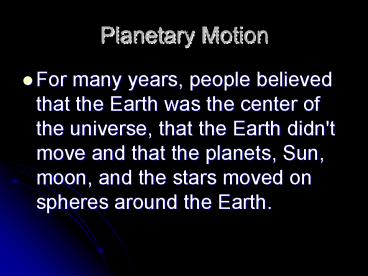Planetary Motion PowerPoint PPT Presentation
1 / 32
Title: Planetary Motion
1
Planetary Motion
- For many years, people believed that the Earth
was the center of the universe, that the Earth
didn't move and that the planets, Sun, moon, and
the stars moved on spheres around the Earth.
2
Planetary Motion
- Astronomers such as Copernicus and Galileo were
the 1st to suggest that the Sun was the center of
the solar system. - Johannes Kepler studied the planets formulated
three laws which describe how the planets move on
their orbits around the Sun.
3
Planetay Motion
- Kepler derived these laws, but he didn't
understand why planets are forced to move in this
way because gravity hadnt been discovered yet. - Kepler's laws are simply a consequence of the
force of gravity between the Sun and the planets.
4
Keplers 1st Law
- 1st Law Orbits are Elliptical
- He discovered that the planets move on ellipses
around the Sun. - An ellipse is kind of a stretched out circle.
5
(No Transcript)
6
(No Transcript)
7
Keplers 2nd Law
- 2nd Law The Speeds of Planets
- Kepler realized that the line connecting the
planet and the Sun sweeps out equal area in equal
time. - This means that when planets are near the Sun in
their orbit, they move faster than when they are
further away.
8
A diagram showing a planet on its elliptical
orbit around the Sun. The shaded areas are of
equal size, and were swept out in equal time,
i.e. it took the same amount of time for the
planet to move from A to B and from C to D.
9
Keplers 3rd Law
- 3rd Law P2 a3
- Kepler's 3rd law means if you know how long it
takes a planet to go around the Sun (P), then you
can determine that planet's distance from the Sun
(a).
10
Keplers 3rd Law
- This formula also tells us that planets far away
from the Sun take longer to go around the Sun
than those that are close to the Sun.
11
Kepler's 3rd Law
12
Earths Rotation
- The 2 main motions of Earth are rotation and
revolution. - Rotation is the turning, or spinning of Earth on
its axis. - Revolution is the motion of a body, such as a
planet or moon, along a path around the sun.
13
Earths Rotation
- The main results of Earths rotation are day and
night. - Each rotation equals 24 hours.
14
Earths Revolution
- Because Earths orbit is an ellipse, its distance
from the sun varies. - Perihelion-when Earth is closest
- Aphelion-when Earth is farthest from the sun
15
Earths Rotation
- The Earth travels around the sun in 365 ¼ days.
- Earth is slightly tilted spins on its axis.
- Since it is tilted, that is why we have different
seasons.
16
Earths Rotation
- During the seasons, there is a change in temps.
and length of daylight. - For example, it is summer when the North Pole is
tilted toward the sun.
17
Earths Rotation
- As the North Pole moves away from the sun, summer
turns to fall and then to winter. - In the winter, the North Pole is tilted away from
the sun.
18
(No Transcript)
19
Moon
- The moon, our only satellite, is about 4 times
smaller than Earth. - A satellite is an object that travels around a
larger object.
20
(No Transcript)
21
Moon
- The moon has a weak gravitational pull so it has
lost its atmosphere. - The moon has no surface air or water.
22
Moon
- Our moon is made up of hills, mountains, plains,
and craters. - There are no clouds, winds, or rain so the moon
has no weather.
23
Moon
- The moon does have extreme temperatures.
- When facing the sun, temps. reach 2500 F.
- Away from the sun, temps. reach -2600 F.
24
Moon
- The moon always keeps the same side facing the
Earth. - We never see the back side of the moon.
- The moon rotates around the Earth in about 29
days.
25
Moons Phases
- The changing shapes of the moon are called
phases. - The moon doesnt change, just our view of the
moon that is lighted.
26
(No Transcript)
27
Moons Phases
- When the moon is between the Sun Earth, its
dark side is facing us. - This is known as a new moon.
- It cannot be seen at all.
28
Moons Phases
- When the moon is on one side of the Earth, and
Sun is on the opposite side, the moon is full. - We have one full moon one new moon each month.
29
Moons Phases
- At different times the shapes of the moon may be
crescent, half, or gibbous (3/4). - These shapes depend on how much of the lighted
half we can see at a particular time.
30
(No Transcript)
31
Moon
- Eclipses occur when Earth, sun, and moon are in a
line. - Solar Eclipse- moon is between the Earth and sun.
- Lunar Eclipse-Earth is between the moon and sun.
32
(No Transcript)

